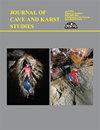新墨西哥州泰勒火山田格兰特岭黑曜岩矿床的地质和地质考古观点对比
IF 0.5
4区 地球科学
Q4 GEOSCIENCES, MULTIDISCIPLINARY
引用次数: 0
摘要
1993年,Julie Stein和Angela Linse在美国地质学会的一篇特别论文(283)上发表了对这些学科中尺度概念的地质和考古研究(Stein和Linse 1993)。在这两个互补的学科中,尺度问题是研究的关键。然而,在许多情况下,这两个学科以非常不同的方式来理解规模。在地质学中,有时比例尺的大小和分辨率受到严格限制,在其他情况下则不受限制。考古学也是如此。明显的区别是在构造或组成上对地质构造的理解。对考古学家来说,将考古遗址精确到毫米是很常见的,这确实是意料之中的。地质学家很少在地质填图中考虑这种比例尺。对石头来源的地质考古制图通常也有更精细的分辨率(Shackley 1998;沙克利等人。我们对泰勒山火山区黑曜岩物源的研究是两种不同尺度观点的交集。戈夫通过深入的研究,正确地将泰勒山的黑曜石描述为来自格兰特岭流纹岩中心,这当然是正确的。然而,沙克利已经确定了两种成分和结构不同的黑曜石“来源”,具有重要的考古意义-规模不同。在地质考古学上被称为“格兰特岭”或“贺拉斯/拉哈拉梅萨”黑曜岩,前者显示出更多的玻璃质结构,不太适合制作石器工具,而后者通常是无色的,是制作石器工具的更好的介质。这种差异反映在该地区的考古记录和考古背景中。地质定义是否不正确?当然不是,但定义的范围是截然不同的,对任何一门学科都同样有意义。在Goff等人(2019年)在“格兰特岭流纹岩”中用地质年代学定义的地图单元进行了两天的实地采样后,对地质考古学和地质学的规模有了更好的了解。事实上,霍勒斯梅萨的一些地图单元,根据对这些单元中黑曜石的地质考古检查,可以扩大。这是规模的问题。我们提出这些推论,既针对泰勒山的具体例子,也作为未来地质和地质考古研究的潜在指南。本文章由计算机程序翻译,如有差异,请以英文原文为准。
Contrasting Geologic and Geoarchaeological Views of Grants Ridge Obsidian Deposits, Mount Taylor Volcanic Field, New Mexico
In 1993, Julie Stein and Angela Linse published, in a Geological Society of America Special Paper (283), a geological and archaeological examination of concepts of scale in those disciplines (Stein and Linse 1993). In both complementary disciplines the issue of scale is crucial for research. However, in many instances the two disciplines conceive of scale in very different ways. At times in geology the size and resolution of scale is tightly constrained, in other situations much less so. The same in archaeology. The obvious difference is in conceiving geological formations either in structure or composition. Mapping archaeological sites down to the millimeter is quite common for archaeologists, indeed expected. Geologists rarely are concerned about this level of scale in geological mapping. Geoarchaeological mapping of stone sources is often at a finer resolution as well (Shackley 1998; Shackley et al. Our research on the obsidian sources in the Mount Taylor volcanic field is where the contrasting views of scale intersected. Goff rightly, and with intensive research, characterizes the obsidian at Mount Taylor as derived from the Grants Ridge rhyolite center, which is most certainly correct. However, Shackley has identified two compositionally and structurally different obsidian "sources" that have important archaeological meaning - the scale is different. Called geoarchaeologically "Grants Ridge" or "Horace/La Jara Mesa" obsidian, the former exhibits a more vitrophyric fabric and a less desirable media for stone tool production, while the latter is generally aphyric and a somewhat better media for stone tool production. This difference is reflected in the archaeological record and archaeological contexts in the region. Is the geological definition incorrect? Of course not, but the scale of definition is quite contrasting, and just as meaningful to either discipline. After spending two days field sampling in Goff et al's (2019) geochronologically defined map units in "Grants Ridge rhyolite" a better understanding of scale for both geoarchaeology and geology has become visible. Indeed, some of the map units on Horace Mesa, based on the geoarchaeological examination of the obsidian in those units could be expanded. It's a matter of scale. We present those inferences, both for the Mount Taylor specific example, and as a potential guide for future geological and geoarchaeological research.
求助全文
通过发布文献求助,成功后即可免费获取论文全文。
去求助
来源期刊

Journal of Cave and Karst Studies
地学-地球科学综合
CiteScore
1.90
自引率
0.00%
发文量
6
审稿时长
>12 weeks
期刊介绍:
The Journal of Cave and Karst Studies is a multidisciplinary journal devoted to cave and karst research. The Journal is seeking original, unpublished manuscripts concerning the scientific study of caves or other karst features. Authors do not need to be members of the National Speleological Society, but preference is given to manuscripts of importance to North American speleology.
 求助内容:
求助内容: 应助结果提醒方式:
应助结果提醒方式:


